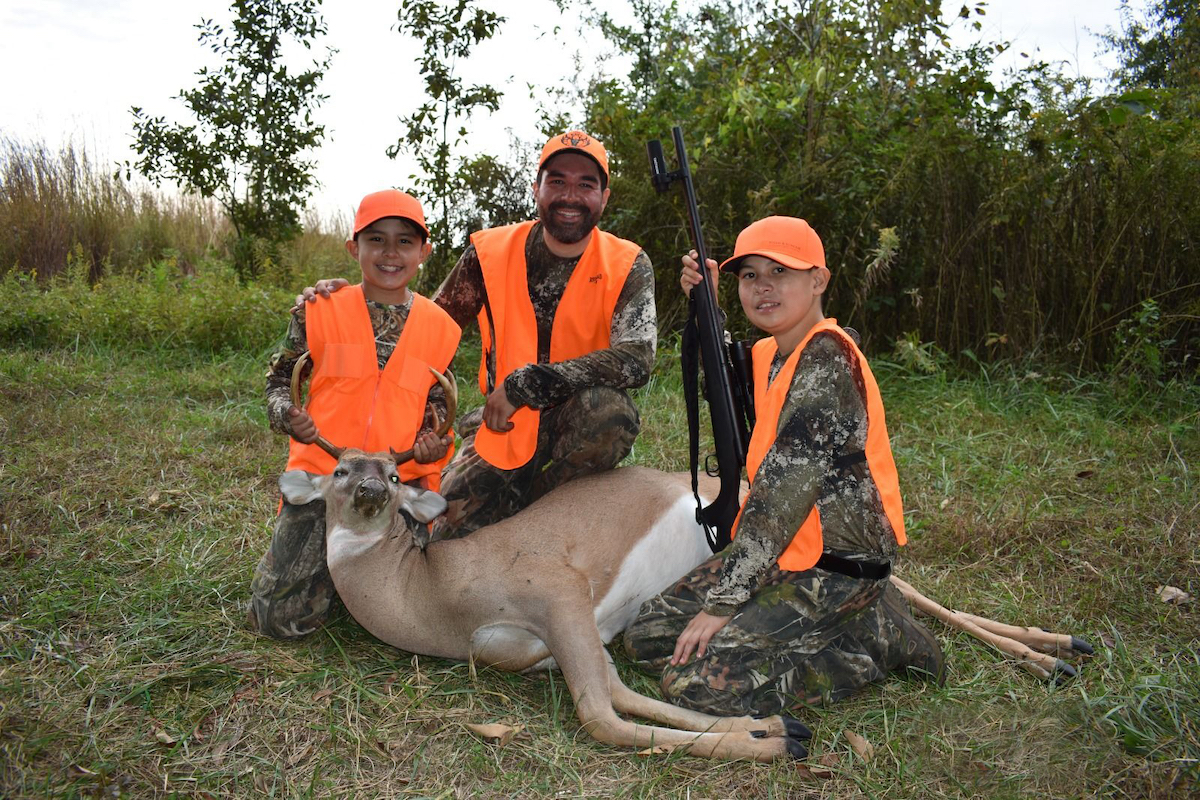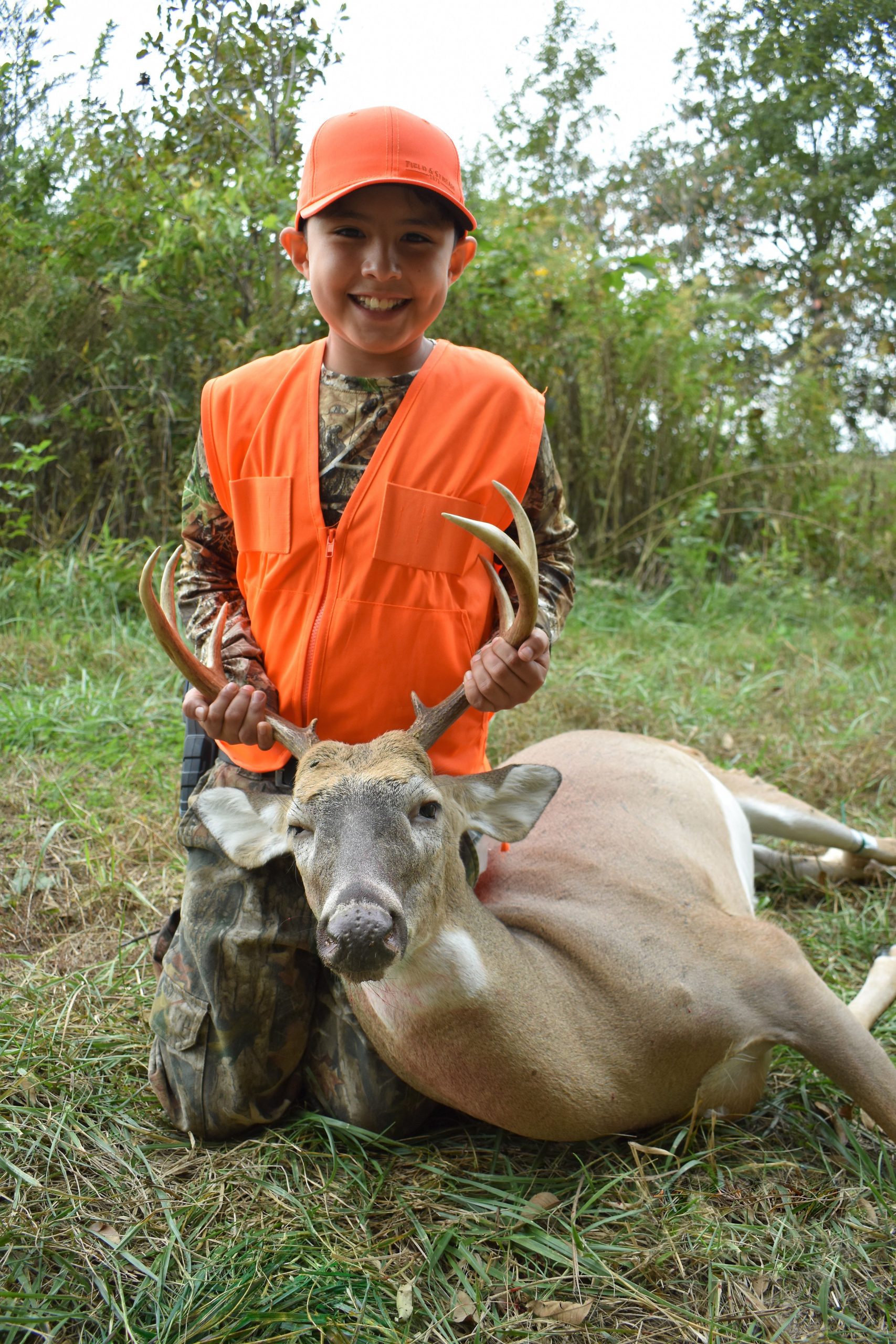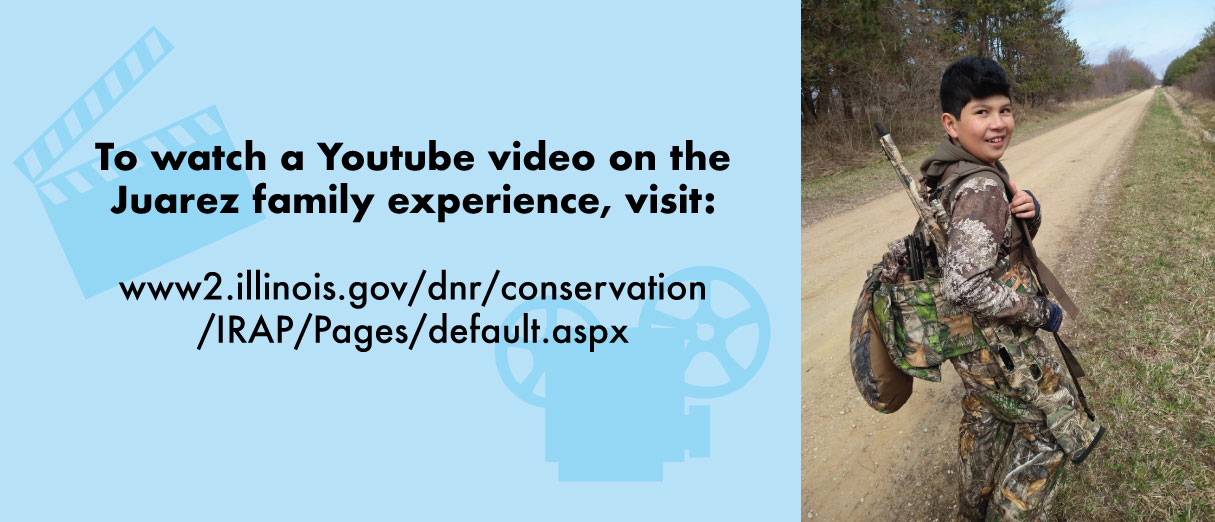
All photos courtesy of Ramiro Juarez.



All photos courtesy of Ramiro Juarez.
How does one become a hunter of deer or other wild game? The answer to this question can depend on a variety of factors, but it usually has a lot to do with how one grows up. Hunting is a recreational activity that many participants first become exposed to at a young age through an older family member or mentor. Hunting knowledge and traditions are often passed from one generation to the next, and many hunting families additionally own land. Owning land provides both a place to hunt game, and the opportunity to learn and practice.

But what if you do not grow up in a family that hunts, or you do not own land? Taking up the sport of hunting can be a lot harder for individuals who did not grow up around it or have a place to go. This is particularly true in Illinois, where 97 percent of land is privately owned. For many hunters, even seasoned ones, finding a place to hunt has become more difficult. While Illinois has public land for hunting scattered throughout the state, finding a place to go that isn’t already saturated with other hunters can feel like a daunting task. This can be felt even more so by individuals interested in hunting, but who lack the experience or the confidence in themselves to try it for the first time in a crowded, public setting.
First-time hunter Ramiro Juarez provides some perspective on how difficult it can first feel, but how ultimately rewarding it can be, to begin hunting as an adult. Juarez has been hunting for about two years. Although it was something he had wanted to do since he was a child, he was never in a position where he could take up the sport until more recently.
Juarez grew up in the northwest suburbs of Chicago, where few opportunities existed for him to learn to hunt or even to interact with people who did hunt wild game. He recalls being around 11 years old when hunting first piqued his interest. His father brought home what Ramiro thought was sausage, but it turned out to be venison provided by one of his father’s coworkers. He enjoyed the venison and became excited at the prospect of hunting for himself. His father, however, was less enthusiastic about the idea.
“I said ‘well hey, can you take me hunting, could we go try it? That sounds really cool.’ And my dad being dad said, ‘no, why would I want to go and stand out in the cold for hours when I can just go buy my meat?’ And that was the end of that. That’s kind of the culture that I come from, ‘Dad says this’ and that’s the end of that.”

Juarez understands his father’s attitude about hunting. His father emigrated to the United States from Mexico in the 1960s. For his father, being here was about working, providing for his family, and trying to live a more comfortable life than where he came from. Much of Ramiro’s family life while growing up revolved around work. Not only did his father have little time for recreational activities, he also would have had nowhere to go hunting. Today, Juarez understands that his own circumstances as an adult allow him the opportunity to take advantage of extra time and pursue things he has wanted to do for a long time.
Juarez no longer sees hunting as an extracurricular activity only for himself, however. Now, more than anything, he wants his children to experience hunting and create lasting memories together. This, above all factors, was what made Juarez decide to finally pursue hunting as an adult. So how did he get started, coming from a family that did not hunt, and having little knowledge on where to go or what to do? Juarez explained that what really got things started for him, was the Illinois Learn to Hunt Program.
The Illinois Learn to Hunt Program is an Illinois Department of Natural Resources (IDNR) sponsored program through the University of Illinois Urbana-Champaign that provides free education and training workshops to teach adult participants how to hunt and prepare a variety of game. Juarez and a buddy stumbled on an Illinois Learn to Hunt Program workshop on waterfowl hunting. Ramiro didn’t even know much about waterfowl at the time, but he thought learning how to hunt birds might be a good place to start learning about hunting. The event was exactly what he needed to get started as he ended up meeting an individual who mentored him on his first deer hunt.
“We got to talking and he ended up taking me on my first hunt in November of 2020,” Juarez explained. “He showed me how to go about doing things. So, through him, I was able to do my first deer hunt, and I was able to determine that it’s something that I enjoy doing and that I want my children to do.”
Juarez’s next goal was to find a place to take his family hunting. As a parent, and first-time hunter, his primary concern was safety.
“I’ve been to these places open to the public and there are 20 to 30 guys all in a relatively small area, and I was not comfortable with that kind of environment to start hunting with my children,” Juarez said.

Luckily, the Illinois Learn to Hunt Program workshop had information about the Illinois Recreational Access Program (IRAP). IRAP is a controlled public access program on private land that is funded through the Natural Resources Conservation Service Voluntary Public Access–Habitat Incentive Program. (VPA-HIP). It is maintained through partnerships between IDNR and other conservation entities. Since its inception in 2011, the program has strived to increase public access, provide outdoor recreational activities, create recruitment, retention, and reengagement in outdoor recreation, and improve habitat on private lands.
IRAP started small, allowing only youth turkey hunting, fishing, and hiking. As demand for IRAP has grown and landowners have become more comfortable with IRAP’s success, more hunting activities have been introduced. As of 2022, IRAP has grown to include more than 27,000 acres in 52 counties leased for youth turkey hunting, adult spring turkey hunting, archery deer hunting, youth shotgun deer hunting, upland game hunting, waterfowl hunting, rabbit and squirrel hunting, and pond and river fishing.
Juarez contacted IRAP and learned about the opportunities available for first time hunters and youths. He likes that IRAP operates on the premise of semi-controlled access, where participants have to apply for access and are then awarded a specific site via lottery.
“That’s probably the reason that [the boys] got to hunt, because if our only option was to take them to public land that’s full of a lot of people hunting, I don’t know that we would have gone,” Juarez said. “Because of IRAP, they had the opportunity to go, and I felt very comfortable with it. I realize as they get older, I’ll be fine taking them to public lands, where there will be more people. But hunting for a 10-year-old is a little different than for others.”

So far, Juarez has only taken his two sons, Arturo, 12, and Diego, 10, hunting with him. Both boys have clearly already developed a lot of enthusiasm for the sport. Their excitement was palpable as they shared stories about their IRAP youth shotgun deer and youth turkey hunts.
“I felt excited when I shot that buck, instantly,” Diego explained. “I was nervous at first that I would hit off and hit it in the back strap. But I shot it right where I was supposed to; I wasted no meat.”
Arturo’s favorite thing about hunting is being out with his dad and brother and being able to get up-close-and-personal with other wildlife. He excitedly shared the story of a coyote walking only yards away from where he sat quietly watching turkeys with his dad and brother.
“I’m sitting there, relaxing, and I look, and there is a coyote next to me,” Arturo explained. “And it is a lot bigger than me.”
“My boys, they’re each very different,” Juarez explained. “Diego is extremely active, so I can take him anywhere, and he will push through if something’s difficult. My other son is autistic, he’s on the spectrum and has a couple learning disabilities. He has more significant needs, but he also likes to do things that his brother does. I want to make sure I can do activities where I can take both my sons with me.”
One of the reasons that Juarez appreciates IRAP is because it attempts to take individual needs into consideration. Arturo can be more sensitive to dramatic changes in elevation, and typically does not like to walk very far. IRAP tries to accommodate specific needs of participants when assigning properties, such as difficulty walking long distances or climbing steep slopes. Juarez explained that if IRAP did not do this, some situations would make it hard for Arturo to participate in hunting.
“I would encourage someone who may have a child that has a learning disability or autism to look into the IRAP program,” Juarez said. “You know these children can do everything that any other children can do when provided slight accommodations. IRAP takes that into consideration.”

Juarez and his wife Xochtl also have two daughters, Natalia, 6, and Annabelle, who is 3. Natalia is the only person in the household who isn’t currently a fan of Juarez’s hunting, but only because she has not yet been able to go. Once she is a little bit older, he will be more comfortable taking her out with the boys.
“She wants to go out there, too,” Juarez noted. “This year she wants to go goose hunting and I told her I’d take her out, but that she’ll just going to sit there [for now] and have some hot chocolate and donuts.”
While Juarez is grateful to IRAP for the opportunities it provides him and his family, he is even more appreciative of the landowners who enroll in IRAP and allow public access on their land. Indeed, without these landowners, IRAP would not be able to provide the hunting opportunities it does to youth and first-time hunters, as well as seasoned hunters.
Landowners are offered an array of incentives to enroll in IRAP. They receive assistance with habitat management by having a plan written or updated and then receiving cost-share assistance to implement it, along with an annual stipend based on total acres enrolled and which activities they choose to allow on their property. Many landowners also take satisfaction in providing opportunities to hunters who otherwise would have nowhere to go. They may also like the idea of a responsible hunter keeping an eye on their property for them, knowing that they can report trespassers or other negative occurrences they may observe.
Juarez and his family are particularly conscious of these last two sentiments. He understands why some people aren’t comfortable with someone they do not know carrying a gun on their property, and he appreciates that IRAP-enrolled landowners give permission so that children like his can experience hunting. He and the boys therefore always make sure that the site they access is better than it was before they leave. The boys, too, wanted to share their gratitude with the landowners.
“Thank you, landowners, for letting us hunt on your property. I know most don’t but, I’m glad that you let us.”
“Thank you for the land we hunted. I really enjoyed it.”

The gap between new and seasoned hunters these days is becoming increasingly noticeable. One of the reasons for this is the lack of places to go, regardless of how long one has been hunting. Hunting doesn’t just provide funding for conservation; it also provides unique outdoor experiences and carries with it traditions that can create lasting memories. Indeed, Juarez views hunting as something he can do with his kids to make memories while they’re young, but also something they can continue doing together over the next 50 years when his children have children of their own.
Luckily in Illinois, programs such as Illinois Learn to Hunt and the Illinois Recreational Access Program exist so that both parents and youth can learn and get involved in hunting at the same time. Without IRAP and the landowners who enroll in the program to allow access to their land, it would be much more difficult for people like the Juarez family to hunt.
“Without the landowners allowing us to hunt their land, I wouldn’t have the experiences and memories that I’m building with my children,” Juarez noted. “For me it’s more about them than about me, you know? I’m not building memories just for myself. I want to create memories with my children and help them gain skills that they can pass down to their children.”
Alex Davis is the IRAP Marketing and Outreach Specialist. She has a degree in Anthropology (B.A.) from SIU Carbondale, and a degree in Environmental Studies (M.A.) from UIS Springfield. She was a graduate student intern with IDNR’s Natural Heritage Database in 2017, and then spent two years working as an ecological restoration technician for Nelson Land Management where she conducted invasive species management, timber stand improvement and prescribed burns. In her free time, she enjoys hiking, botany, mycology and nature photography.
Submit a question for the author